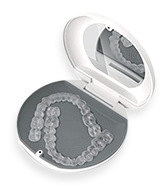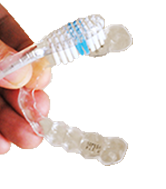
Have questions?
Let us answer them...
Your questions can be the same of many others, let us guide you to your relatable doubts..
- Home
- FAQ
- Frequently asked questions by Doctors
- Ipr Procedure For Aligner
Ipr Procedure For Aligner
• To begin with, rotated teeth should be aligned prior to reduction if possible to arrange the contact points in a more suitable position.it is optional to separate the teeth 3-4 days before IPR. Coil spring /separators are be used to open space, improving visual and mechanical access and depressing dental papillae to reduce trauma (with separators). This step of procedure is often done when the teeth are too rotated and for reduction to be performed prior to alignment. Space opened by coil spring or separators should be measured before reduction to avoid over- stripping. Interdental papillae should be protected with thin brass /steel indicator wire.
• In the process of IPR, an ultra-fine diamond disc should be placed in the interdental space at first followed by reducing mesiodistal widths to the desired dimension. Subsequently, the disc should be inserted below the contact point & swept occlusally. It is suggested that measurements tools be applied to ensure adequate enamel reduction is performed as planned previously. It is important to ensure that contact point remains 4.5-5 mm away from the bone crest. If it is too away from bone crest, black triangle may be visible. However, if it is too close, the size of the col will become larger, leading to increased periodontal pocket.
• After reducing the enamel, it is necessary to contour the tooth to normal shape with appropriate embrasure width suitable for oral hygiene.it is also recommended to restore the contact point it is brought more apically after reduction. These procedure can be carried out with the bur, an ultra-thin diamond disc or sof-lex disc. Next, polishing paste can be used to make the surface smoother. Some researchers suggested 35% phosphoric acid in conjunction with fine abrasive strip for better recontouring.
• Subsequent to recontouring, steps should be performed to protect the enamel from increased risks of caries. Various strategies have been suggested, including 8% stannous fluoride for 4 minutes, fluoride mouth rinses for 45 days & 0.05% neutral sodium fluoride mouth rinses once daily. Some researchers also recommended that the use of regular professionally applied fluoride (1.23% acidulated phosphate fluoride for 4 minutes together with fluoridated dentifrices daily. Others suggested casein phosphopeptide-amorphous calcium phosphate tooth mousse for enamel’s re-mineralization into subsurface layers. Applying sealant after etching for 20 seconds is another approach, yet it may not last long. Sheridan suggest posterior stripping be performed one site at a time from the most posterior site. After enamel was reduced at one site, space should be closed before another stripping on the visit in order to gain better control and prevent over stripping. Special attention should be attain to anchorage control at the same time.
IPR gauge is stainless steel measurements gauge to confirm the correct interproximal gap.
You can buy IPR gauges on online sites or from any other dental dealer.
• There are several indication for IPR in clinical practice. First, it is applied in conjunction with active orthodontic treatment, especially in cases with class I inter arch relationship accompanied by Bolton’s tooth size discrepancy and cases with mild to moderate crowding of 3-4 mm.
• Second it can be used independently to relieve limited crowding and allow self-alignment of dentition (including the mixed dentition). The self-alignment usually takes about 4 to 6 months. Disking primary posterior teeth in conjunction with space maintenance is an effective method to prevent translational crowding and abnormality in the eruption of permanent teeth by utilizing the leeway space and all available arch length.
• IPR is also used to treat black triangle for improvement of aesthetics. After the reshaping of interproximal contour, contact points of adjacent teeth can be brought apically. Thus, bulbous teeth promises the better prognosis because of greater improvement of interproximal contact relationship.
• Besides, IPR is used for cosmetic recontouring, most commonly in reshaping canines to mimic lateral incisors.
• Another indication of IPR is for post treatment prophylaxis in prevention of potential crowding during retention. In cases when relapses have taken place, striping is advisable to allow realignment without labial tripping of anterior teeth into unstable position.
No. As we only reduce the enamel part of tooth which is only 0.2 to 0.5 mm that it is not near to the dentin so IPR of tooth not causes sensitivity. Even in one of IPR case sensitivity occurs it can be cure by advising sensodyne which contains aqua, sorbitol, hydrated silica, glycerine, potassium nitrate, cocamidopropyl betaine, aroma, xanthan gum, sodium saccharin, sodium hydroxide, sucralose, limonene.
• It is suggested that IPR be conducted on three occasions- when incisor alignment is achieved, at de-bonding and during retention if necessary. The amount of interproximal reduction should be carefully planned ahead of treatment with the enamel thickness of various tooth positions in mind. Enamel thickness of lower central incisors is 0.77+ 0.11mm and 0.72+ 0.10 mm at distal and mesial surface respectively, in comparison with 0.96+ 0.14mm and 0.80+ 0.11 mm respectively foe lower lateral incisor.
• Enamel is thickest at upper canines and distal surface of upper central incisor. There is approximately 1mm of enamel at premolars. Second molars often have a thicker enamel than premolars by 0.3 to 0.4 mm. for all tooth types, distal enamel is thicker than mesial enamel. It was found that there was no relationship between the tooth size and enamel thickness. Therefore, bigger tooth do not necessarily indicate larger amount of enamel to be reduced. However, no relationship can be identified between tooth shape and enamel thickness. Thus, clinical decision should be cautious when referring to tooth morphology. It is recommended that up to 50% of interproximal enamel can be removed during IPR the appropriate amount should be 0.5mm (0.25mm each side) for each tooth whereas up to 0.75mm for posterior teeth.
• With 50% of enamel reduction per tooth, up to 8.6mm space can be created by IPR of mandibular teeth. Even if the amount of enamel reduction is the same, space gained from IPR can be vary according to the shape of teeth. For instance, more space can be obtained by reducing triangular shaped teeth than rectangular shaped teeth.
• Amount and site of IPR can be determined by Bolton’s ratio in case of tooth size discrepancy. For instance, if total ratio indicates excessive tooth size of 4mm with normal anterior ratio in upper arch, enamel reduction should be done in premolar a molar region of upper arch. If total ratio reveals excessive tooth size of 4mm in upper arch while anterior ratio suggest 2mm excessive in upper anterior region, reduction should performed on all upper teeth. The golden proportion advocated by rickets can also be employed to determine the site and amount of enamel to be reduced.
• Another guide to interproximal reduction for incisors is the peck index. This index employs the ratio of mesiodistal to faciolingual dimension (MD/FL ratio0 to indicate the alignment of lower incisors. It was found that lower incisor that were naturally well aligned often demonstrated smaller MD/FL ratio they suggested that the favourable MD/FL ratio to achieve good alignment of lower incisors should be within 88-92% for central incisors and 90-95% for lateral incisor. There has been contend on the relationship between incisor shape and mal-alignment and relapse.
• Absolutely not. Amount of IPR will depend on the severity of malocclusion and it differs from patient to patient. The aim of this reduction is to create space for ideal tooth alignment during orthodontic treatment and to give teeth a suitable shape whenever problems of shape or size require attention.
• IPR is indicated in crowding of teeth, inter arch size discrepancies, macrodontia and discrepancies, crowding of mandibular incisors, in normalization of gingival contour and elimination of triangular spaces above the papilla (dark triangular), correction of the curve of spee and in multiple tooth rotation.
• In normal orthodontic cases it is not needed. It should not be performed in cases like severe crowding (more than 8mm per arch), poor oral hygiene, small teeth and hypersensitivity to cold, susceptibility to decay or multiple restoration, severely rooted teeth.
Reducing the mesio-distal size of teeth by removing enamel in the procedure known as interproximal stripping.
IPR by strips
The fundamental principles of stripping-
Separate the teeth, by putting separators in place on a previous appointment, before stripping them as to improve access, as Sheridan advices.
• Always strip from the posterior to the anterior to prevent any loss of space being gained from slippage resulting from the anterior component of force.
• Always protect adjacent soft tissue with cotton rolls and wooden wedges.
• Always reshape the stripped teeth to their proper from and restore the remaining enamel surface to its original smoothness, polishing being essential.
• Finally, according to Sheridan prescribe a fluoride solution that patients can use to increase the potential for remineralization of the abraded enamel surfaces.
Advantages of stripping
• Need for extractions is eliminated and the possible undesirable consequences of extraction are avoided.
• Less tooth movement is required.
• Treatment time is shortened.
• Increase probability of stable results.
IPR by burs
To avoid these impediments Sheridan recommends using special burs with “deactivated” points (ideal burs) that won’t create ridges in the proximal enamel .he prefers tungsten carbide burs for posterior and lateral sectors and diamond burs for anterior region. Diamond and tungsten burs are, in addition, used for taking proximal bulk from amalgam and composite restorations.
Bur is preferred over the stripping when the IPR is more than 0.2mm because stripping increases the chair time.
The IPR system is safe and innovative interproximal reduction system that makes interproximal enamel stripping efficient and accurate without creating sharp corners or subgingival ledges. Designed for use with aligners and other orthodontic treatments, these flexible diamond strips curve and conform to the natural contours of the teeth to maximum patient comfort and safety.
Single sided IPR strip is used for IPR of single tooth & double sided IPR strip is used for IPR of multiple teeth for instance when interproximal reduction of distal side of lower central incisor and mesial side of lower lateral incisor or it is used in IPR of contact points of adjacent teeth.
• IPR and enameloplasty is different procedure. Interproximal reduction (IPR) (also called interproximal enamel reduction/slendering, ) is the practice of mechanically removing enamel from between the teeth to achieve orthodontic ends, such as correct crowding, or reshape the contact area between adjacent teeth.
• Enameloplasty is an aesthetic dental procedure to remove small amounts of tooth enamel to change a tooth’s size, shape, length, or surface. Enameloplasty is also known as odontoplasty/ tooth recontouring/tooth reshaping. The procedure is typically performed on anterior teeth for aesthetic reasons, such as fixing a chipped tooth or making teeth a more uniform length.
IPR report can be divided into quadrant according to teeth numbering system which is divided into four quadrant. In first quadrant first row of that quadrant represent the tooth number. Second row suggest the surface of teeth like mesial & distal surface of individual tooth which is mentioned in black colour in IPR report. Third row suggest the amount of IPR should be done in patient like at the mesial surface 0.2 mm or at the distal surface 0.1mm which is mentioned in red colour in IPR report.
Yes. Another rubber base impression is needed after performing the interproximal reduction of teeth. Because interproximal tooth reduction is done for creating the space so we can retract tooth at their proper position. Once IPR is done according to the IPR chart take the rubber base impression and send it to the lab for fabrication of aligner.


